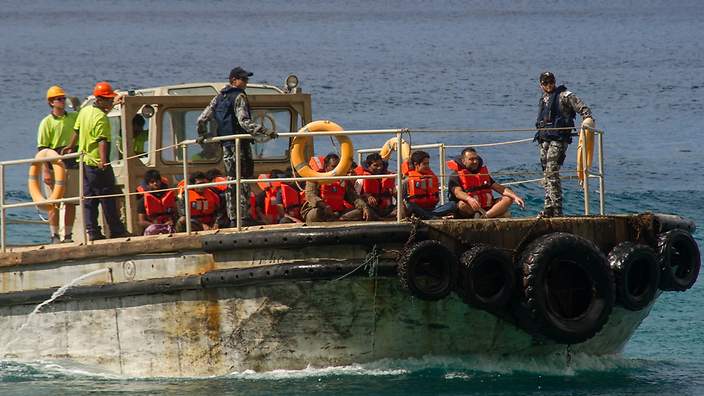The Manus Island and Nauru offshore detention centres are proving to be not feasible. But there is an unlikely solution: a temporary safe haven processing facility in India, writes former Case Manager and international relations academic Richard Curzon.
The recent violence at the Manus Island detention centre and the numerous asylum seekers who have drowned at sea while trying to make the perilous voyage to Australia make it clear that Australia’s asylum seeker policy of offshore processing in Papua New Guinea and Nauru is not working. But perhaps there is another solution: a safe haven processing facility in India.
Australia and India share a bilateral relationship with a particular focus on security and strategic issues. There is co-operation in science, technology, international education and research across India and the region, which includes Afghanistan, Pakistan, Nepal, Bhutan, Bangladesh, Sri Lanka and the Maldives.
India is not a full signatory to the 1951 UN Refugee Convention or its 1976 Protocol; however, it continues to grant asylum and provide direct assistance to some 200,000 refugees from neighbouring states and is a member of the Bali Process Ad Hoc Group. More than 80,000 Tamil refugees live in special refugee camps in the south Indian state of Tamil Nadu, home to 60 million Tamil speakers. The camps are funded and run by the Indian government, with thousands more Tamils living in city communities such as Chennai.
By engaging with member countries of the Bali Process Ad Hoc Group, the United Nations High Commissions for Refugees and the South Asian Association for Regional Co-operation, in particular India, Australia can demonstrate leadership through a diplomatically negotiated, multilateral agreement to establish a regional safe haven facility in India managed by an integrated multinational workforce.
A significant investment from Australia to plan, construct and operate a regional safe haven transit facility would clearly be necessary, but in the long run Australia would save billions of dollars in operational costs by closing the Manus and Nauru offshore detention centres.
Asylum seekers from Afghanistan, Iran, Pakistan, Sri Lanka and Iraqi and Syria who arrive in Australian waters would immediately be relocated by air to the dedicated “safe haven waiting room” in India. This action alone would deter arrivals by boat to Australia when it is understood that mandatory regional processing will take place in India.
An enduring and sustainable solution lies in managing the movement of asylum seekers closer to their point of origin and providing a safe pathway to a secure destination from which they can apply for protection. If their applications are successful, the existing process for arrival by air and settlement in the Australian community would follow.
The idea of a safe haven transit facility might be new to Australia and the region, but it has been successfully implemented in Europe. In 2003 in Zagreb, Croatia, a village was constructed to accommodate asylum seekers from the Balkans and eastern Europe bound for Great Britain. The International Organisation for Migration was to manage the centres, and the UNHCR would process the refugee applications. In his book Borderline: Australia’s treatment of asylum seekers and refugees, Peter Mares explains that Britain intended the Croation facility to be one of a network of regional transit processing centres where asylum seekers could safely be processed.
An Indian safe haven would remove the engagement with people smugglers to facilitate travel from Karachi, Lahore and Dubai to Bangkok, Kuala Lumpur and Jakarta prior to their departure to Australia. It would also disconnect the chain of civil service corruption that produces fraudulently obtained passports, visas and travel documents to the people trafficking industry. And importantly, it would create a life-saving alternative to boat travel to Australia.
The location of a regional safe haven facility would ensure that the customs and traditions of the region continue in a similar cultural, religious and linguistic environment to the asylum seeker’s homeland while accommodated at the transitional facility. This would reduce mental health vulnerabilities that are associated with displacement and persecution.
A temporary safe haven facility in India would offer the services found in refugee camps currently operated by the UNHCR, including the development of new livelihood strategies to help refugees to become self-reliant through training, employment and entrepreneurship opportunities in co-operation with local government authorities and civil societies.
English language classes and orientation to Australian culture, optional but highly recommended services already provided at onshore Immigration detention centres in Australia, would also be offered in a safe haven facility.
Australia would be well advised to take note of history and explore the frequently recommended regional processing pathway. The focus of the solution must be on mandatory regional processing, not mandatory detention.
When coastal conditions in Indonesia return to calm and the monsoon season has moved on in the coming weeks, boats bound for Australia will again, inevitably, run the gauntlet with the Australian Navy.
Now is the time for Australia to think beyond the boats for a sustainable and enduring solution.
